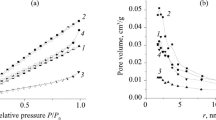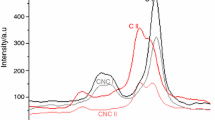The effect of nanocrystalline cellulose (NCC) content on the morphology and strength characteristics of its composites with poly(ethylene oxide) (PEO), polyvinylpyrrolidone (PVP), and their mixture is studied. The miscibility of PEO and PVP improves if NCC is added. Scanning electron microscopy images showed that rearrangement of PEO crystalline regions and sorption of PVP on NCC particles improves the homogeneity of the composite structure and improves the strength characteristics.
Similar content being viewed by others
Explore related subjects
Discover the latest articles, news and stories from top researchers in related subjects.Avoid common mistakes on your manuscript.
Biodegradable polymers and polymer composites are attracting increasing interest because of environmental protection issues. Recently, natural organic nanofillers have tended to be used because of their advantages over traditional inorganic nanofillers, i.e., lack of toxicity, biodegradability, and biocompatibility. Nanocrystalline cellulose (NCC) is drawing attention as a nanosized reinforcement for polymer matrices because it combines uniquely the required physical properties and environmental advantages. NCC consists of rod-like crystallites produced by removing amorphous cellulose regions via acid hydrolysis [1,2,3]. The particles have diameters of 5-50 nm and lengths of 100-3,000 nm (depending on the source and hydrolysis conditions) and possess a large specific surface area, high elasticity modulus, and high ratio of geometric dimensions [4, 5]. All this enables NCC to be used as an effective reinforcing additive. NCC is biocompatible and biodegradable. Furthermore, NCC can act as a compatibilizer for two immiscible polymers [6].
The present work studied the effect of NCC additives on the morphology of poly(ethylene oxide) (PEO) and polyvinylpyrrolidone (PVP), their miscibility, and the strength properties of the resulting composites.
Compatibility studies of different polymers consider characteristics such as crystallinity, molecular mass, main-chain polarity, ability to form physical and chemical bonds, and fundamental differences in their supramolecular structures.
PEO is a simple hetero-chain polyether. Its chain includes the simple repeating monomer [–CH2CH2O–]n. PEO has a distinctly crystalline structure. So-called spherulites, i.e., spherically symmetric lamellar constructs, form during its crystallization [7, 8].
PVP is a linear polymer with an elemental unit containing a side pyrrole ring that can be considered planar to a good approximation. The synthesis of stereoisomeric PVP has not been reported. Apparently, the lack of stereoisomeric species can be explained by the lack of crystallized PVP.
Mixtures of crystalline PEO and amorphous PVP are of practical and scientific interest because PEO is used to fabricate various thin-film materials for sensors and electrochemical devices. The present work studied the possibility of using NCC to improve the compatibility of PEO and PVP, which differ substantially in molecular mass and degree of crystallinity.
Materials. PEO, PVP, and microcrystalline cellulose (MCC, particle size ~20 μm) were purchased (Sigma-Aldrich). Table 1 presents the characteristics of the polymers used to produce the composites.
NCC preparation. Aqueous suspensions of NCC were prepared by H2SO4 hydrolysis of MCC using the published method [9]. MCC was hydrolyzed in aqueous H2SO4 (62%) at 50°C for 2 h with vigorous stirring. The resulting suspension was rinsed with distilled H2O multiple times to remove the acid by centrifuging until the supernatant liquid reached a constant pH value (~2.4). Then, the NCC suspension was purified using ion-exchange resin, irradiated with ultrasound for 15-30 min, and used to prepare polymer/NCC composite films. NCC was dried in polystyrene Petri dishes with natural evaporation of water for x-ray structure and thermal analyses.
Preparation of composite films of polymer/NCC was reported earlier [10]. First, an aqueous solution of the polymer (PEO, PVP, or their mixture) was prepared by dissolving polymer (0.5 g) in distilled H2O (10 mL) at room temperature. The PEO:PVP ratio was 1:1 in the prepared polymer mixture. The required amount of NCC suspension of known concentration was added. The resulting mixture was stirred vigorously for 1 h, poured into Petri dishes, and dried under normal conditions for 1-2 d.
PEO-NCC, PVP-NCC, and PEO-PVP-NCC composites with various NCC contents were obtained. The designation PEO-NCC3 will be used from hereon for 3% NCC in the composite; PEO-NCC9, 9% NCC in the composite, etc.
Study methods. The degree of NCC crystallinity was calculated using x-ray structure analysis (XSA) data [11]. The dimensions and surface charge of NCC particles in the aqueous suspension were estimated from the ζ-potential (Zetasizer Nano ZS). The degree of cellulose polymerization was determined from the viscosity of its Cadoxen solutions [12].
The morphology of the dried NCC samples was studied using a VEGA3 TESCAN scanning electron microscope (Czech Rep.). Images were taken at accelerating potential 5 kV under high vacuum. Elemental analyses of dried samples used energy-dispersive x-ray analysis with an Oxford Instruments accessory.
Strength characteristics of composite films were measured on a 2099P-5 tensile tester (Russia) using tension at room temperature. The greatest limiting load was 5 kN; displacement rate, 1 mm/min.
NCC that was prepared by acid hydrolysis consisted of anisotropic nanosized particles in an aqueous suspension. Table 2 lists the characteristics of the NCC.
Morphology of PEO-NCC and PVP-NCC composites. PEO crystallizes to form so-called spherulites, i.e., spherically symmetric lamellar constructs (Fig. 1a). SEM images of the surface and a chip of the PEO-NCC films showed that the NCC additive altered considerably the PEO microstructure. The number of spherulites increased and their sizes decreased with 3-10% NCC. A disordered fibrous PEO structure formed if the NCC content was increased to 25% (Fig. 1d). The change in the microstructure led to a change in the physical properties of the PEO-NCC composites. Figure 1 shows that the size of spherulites in film prepared from 5% PEO solution by drying at room temperature was 40-50 μm. The spherulites were not fully intergrown. The film had voids, which was responsible for the low density of the pure PEO film. The density of the composites reached a maximum near an NCC content of 25-30% (Fig. 2), where the structure changes, spherulites are destroyed, and a fibrous structure is formed.
Ordered layered structures were formed if NCC was added to PVP (Fig. 1g-j). Visible structural elements could be identified as NCC particles with PVP molecules adsorbed on them. The density of PVP-NCC composites changed insignificantly with composition. Adsorption of PVP to NCC could be confirmed by the change of NCC charge in the presence of PVP (Fig. 3). The negative charge of NCC particles (–61 mV) was compensated practically to zero after PVP adsorption.
Morphology of PEO-PVP composites. SEM images showed that films prepared from mixtures of PEO and PVP had nonuniform structures. Spherical constructs of diameter 20-40 μm in the polymer matrix were visible on the film surface (Fig. 4a and 4b). The boundary between the spherical constructs and the matrix had ruptured in several places (Fig. 4c).
Elemental distributions in an area of 150 × 150 μm were analyzed to identify the polymers in the resulting structure. The elemental compositions of PEO and PVP are different. PVP contains N. The fraction of O in the two polymers is considerably different (14% in PVP, 52% in PEO). Mapping showed that O was contained primarily in the matrix polymer; N, primarily in the polymer spherical constructs. Thus, PVP could be considered spherical drops distributed in the PEO matrix. The PEO did not crystallize as spherulites but existed as separate lamellae.
Morphology of PEO-PVP-NCC composites. SEM images of surfaces and chips of PEO-PVP-NCC films showed that a uniform structure formed if NCC was added (Fig. 5). Mapping of PEO-PVP-NCC composites established that the polymers were uniformly mutually distributed. A possible mechanism for this effect was discussed before [6], i.e., H-bond formation of PEO ethers and PVP carbonyls with NCC hydroxyls.
Strength properties of the composites. Stretching diagrams of the composite films were used to determine the tensile strength (σ), relative elongation (εb), and Young’s modulus (E). Table 3 shows that adding NCC increased the tensile strength of PEO-NCC composite film by ~2; of PVP-NCC film, by 1.5 times. Young’s modulus increased by 4-5.5 times for this system. It is noteworthy that the strength characteristics reached a maximum with 25-30% NCC in both composites. The mechanical properties of PEO-PVP and PEO-PVP-NCC composites were substantially below those of PEO-NCC and PVP-NCC composites. The strength characteristics of PEO-PVP composites could not be measured because they were very low. However, adding NCC strengthened the films.
References
Y. Habibi, L. A. Lucia, and O. J. Rojas, Chem. Rev., 110, No. 6, 3479-3500 (2010).
G. Siqueira, J. Bras, and A. Dufresne, Polymers, No. 2, 728-765 (2010).
S. J. Eichhorn, A. Dufresne, et al., J. Mater Sci., 45, No. 1, 1-33 (2010).
J. George, K. V. Ramana, et al., Int. J. Biol. Macromol., 48, No. 1, 50-57 (2011).
H. Zhu, W. Luo, et al., Chem. Rev., 116, 9305-9374 (2016).
C. Yong, C. Mei, et al., J. Appl. Poly. Sci., 135, No. 9, 45896 (2018).
S. Z. D. Cheng, J. S. Barley, and P. A. Giusti, Polymer, 31, 845-849 (1990).
M. Yang and C. Gogo, Eur. J. Pharm. Biopharm., 85, 889-897 (2013).
D. Bondeson, A. Mathew, and K. Oksman, Cellulose, 13, No. 2, 171-180 (2006).
O. V. Surov, M. I. Voronova, et al., Carbohydr. Polym., 181, 489-498 (2018).
A. Thygesen, J. Oddershede, et al., Cellulose, 12, No. 6, 563-576 (2005).
M. Ioelovich and A. Leykin, Sci. Isr. – Technol. Advantages, 6, No. 3-4, 17-25 (2004).
The work was financially supported by RSF Grant No. 17-13-01240. Equipment of the Common Use Center Upper Volga Regional Physicochemical Research Center was used.
Author information
Authors and Affiliations
Corresponding author
Additional information
Translated from Khimicheskie Volokna, No. 4, pp. 36-40, July—August, 2018.
Rights and permissions
About this article
Cite this article
Zakharov, A.G., Voronova, M.I., Surov, O.V. et al. Morphology and Strength Characteristics of Composites Based on Nanocrystalline Cellulose and Water-Soluble Polymers. Fibre Chem 50, 288–292 (2018). https://doi.org/10.1007/s10692-019-09977-4
Published:
Issue Date:
DOI: https://doi.org/10.1007/s10692-019-09977-4









